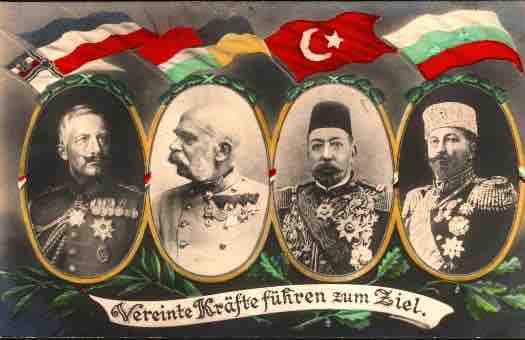In the early part of the 20th century, Europe was still a continent under the control of competing empires who maintained a balance of power through a series of fluctuating treaties known as the Concert of Europe. Shortly before the outbreak of World War I these powers consisted of Germany, Austria-Hungary and the Kingdom of Italy in an association known as the Triple Alliance; Russia, France and the United Kingdom of Great Britain and Ireland made up the rival Triple Entente. At the time the Ottoman Empire maintained separate power on the southeast edge of Europe in Turkey.
Assassination and Diplomatic Crisis
Austria-Hungary was a patchwork of several nationalities – including Czechs, Poles, Slovaks, Romanians, Slovenians, Croats, and Serbs – ruled by the Habsburg dynasty, who were resented by many nationalists of the smaller countries within the empire. In the summer of 1914, Archduke Franz Ferdinand of Austria was on a trip to the city of Sarajevo in Bosnia, the region of the empire bordering Serbia. It was here that Gavrilo Princip, a Bosnian Serb student and member of the radical Young Bosnia group, assassinated the heir to the Austro-Hungarian throne on June 28, 1914.

Archduke Franz Ferdinand
The assassination of Archduke Franz Ferdinand set off a series of war declarations across Europe, ultimately leading to World War I.
Ferdinand’s killing sparked a month of diplomatic maneuvering among Austria-Hungary, Germany, Russia, France, and Britain called the "July Crisis." Hoping to crush Serb nationalism and end Serbian interference in Bosnia, Austria-Hungary delivered the "July Ultimatum", a series of ten intentionally unacceptable demands meant to provoke a war with Serbia. When Serbia agreed to only eight of the ten, Austria-Hungary declared war on July 28, 1914.
Choosing Sides
In response to the declaration, several alliances formed through treaties written in previous decades were invoked, and within weeks the major powers were at war; via their colonies, the conflict soon spread around the world. Russia pledged to aid its longtime Serb protégés, unwilling to give up influence among its fellow ethnic Slavic people in Austrian-Hungary’s southern Balkan region. (Russia would eventually withdraw from the war due to an internal uprising, the Bolshevik Revolution.)
Austria-Hungary appealed to Germany, whose Emperor Wilhelm II offered a “blank check” providing any support necessary to win the war. The German Empire mobilized its troops on July 30, 1914, ready to apply the "Schlieffen Plan," a quick, massive invasion of France meant to demolish its army. The plan, however, required German troops to pass through the neutral nation of Belgium on its way to northern France. When Belgium refused, Germany violated Belgian neutrality by crossing its territory to attack the French forces that had mobilized to meet the invaders. Belgium appealed to the United Kingdom and the British House of Commons threatened war unless Germany withdrew from Belgium. The Germans refused and the UK joined the battle alongside France. Meanwhile, Germany had also turned its attention east by declaring war on Russia, bringing all the major powers into play.
Solidifying Alliances
Thus, Europe was divided into two warring camps: the Allies, based on the Triple Entente of the United Kingdom, France and Russia, and the Central Powers, based on the Triple Alliance of Germany, Austria-Hungary and Italy; although, as Austria-Hungary had initiated the offensive, Italy did not immediately enter the war. These alliances both reorganized – Italy later fought for the Allies – and expanded as more nations entered the conflict, either through treaties with neighboring powers such as Bulgaria and the Ottoman Empire, or due to their status as colonies of the various European powers.

The Central Powers
This WWI postcard shows Central Powers monarchs: Germany (Prussia), Austria-Hungary, the Ottoman Empire, and Bulgaria.